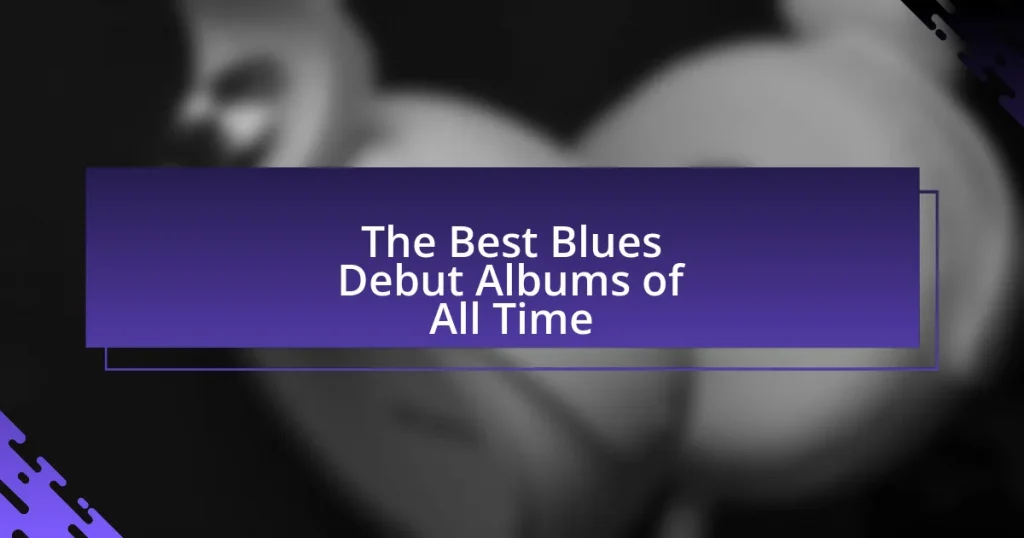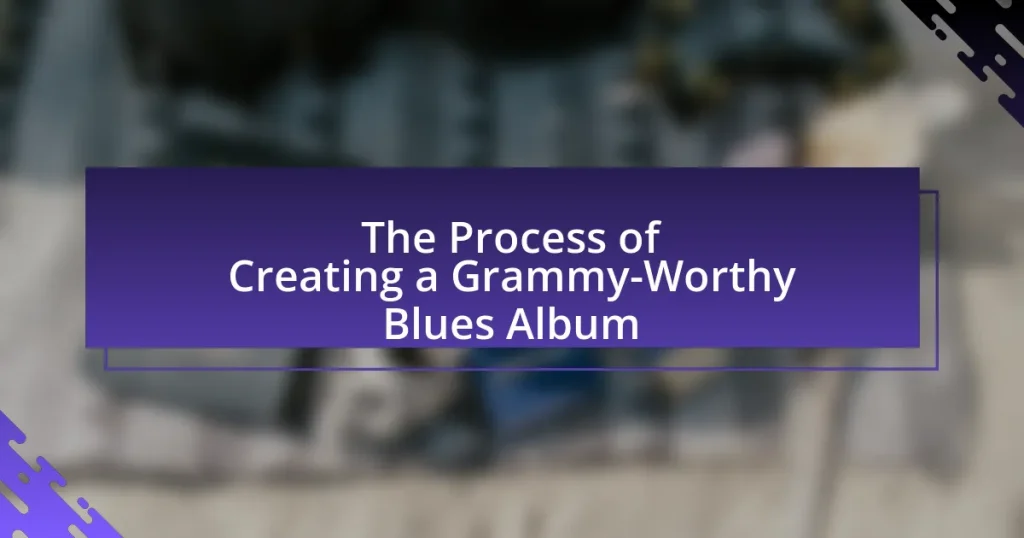The article focuses on the influential role of album producers in the blues genre, highlighting their responsibilities in shaping sound, selecting songs, and overseeing the recording process. It discusses the impact of notable producers such as Willie Dixon, Jerry Wexler, and Sam Phillips, who have significantly contributed to the evolution of blues music through innovative techniques and collaborations with iconic artists. Key topics include the techniques used by producers to enhance the blues sound, the criteria for assessing their influence, and the challenges they face in the industry. Additionally, the article explores modern producers redefining the genre and offers insights for aspiring producers on developing their unique sound while maintaining authenticity.

What defines the role of album producers in the blues genre?
Album producers in the blues genre are primarily responsible for shaping the sound and direction of a recording project. They collaborate closely with artists to select songs, arrange music, and oversee the recording process, ensuring that the final product reflects the intended artistic vision. Notably, producers like Willie Dixon and Jerry Wexler have played pivotal roles in defining the blues sound by integrating traditional elements with innovative techniques, thus influencing the genre’s evolution. Their expertise in sound engineering and music production has been crucial in capturing the emotional depth and authenticity characteristic of blues music.
How do album producers influence the sound of blues music?
Album producers significantly influence the sound of blues music by shaping the recording process, selecting instrumentation, and guiding the overall artistic direction. They make critical decisions regarding the arrangement of songs, the choice of studio techniques, and the blending of various musical elements, which can enhance the emotional depth and authenticity of the blues genre. For instance, producers like Willie Mitchell and Jerry Wexler have been known to incorporate orchestral arrangements and innovative recording techniques that have defined the sound of iconic blues albums, demonstrating their pivotal role in the evolution of the genre.
What techniques do producers use to shape the blues sound?
Producers shape the blues sound through techniques such as careful selection of instrumentation, vocal arrangement, and recording techniques. By choosing specific instruments like the guitar, harmonica, and piano, producers create a distinctive blues atmosphere. Additionally, they often emphasize raw vocal delivery and emotional expression, which are central to the genre. Recording techniques, including the use of analog equipment and live recording sessions, help capture the authentic sound and feel of blues music. Historical examples include producers like Sam Phillips, who utilized these techniques to enhance the sound of artists such as B.B. King and Howlin’ Wolf, solidifying their impact on the blues genre.
How does a producer’s vision impact the final album?
A producer’s vision significantly shapes the final album by determining its overall sound, style, and artistic direction. This vision influences decisions on instrumentation, arrangement, and vocal delivery, ensuring that the album aligns with the intended emotional and thematic goals. For instance, legendary producer Willie Mitchell’s vision for Al Green’s albums emphasized a smooth, soulful sound that became a defining characteristic of Green’s music, leading to critical acclaim and commercial success. This demonstrates how a producer’s foresight can create a cohesive and impactful listening experience, ultimately affecting the album’s reception and legacy.
Why are certain producers considered influential in the blues genre?
Certain producers are considered influential in the blues genre because they have significantly shaped the sound and direction of blues music through their innovative techniques and artist collaborations. For example, producers like Sam Phillips, who founded Sun Records, played a crucial role in launching the careers of iconic blues artists such as B.B. King and Howlin’ Wolf, thereby influencing the genre’s development. Additionally, producers like Jerry Wexler at Atlantic Records were instrumental in blending blues with other genres, which helped to popularize the music and reach wider audiences. Their contributions not only enhanced the production quality but also defined the stylistic elements that characterize blues music today.
What criteria determine a producer’s influence in blues music?
A producer’s influence in blues music is determined by their ability to shape the sound, style, and overall artistic direction of the recordings. This influence is often assessed through their track record of successful albums, collaborations with prominent artists, and innovative techniques that enhance the genre. For instance, producers like Willie Mitchell and Jerry Wexler are noted for their distinctive contributions to the sound of blues, with Mitchell’s work with Al Green and Wexler’s collaborations with Aretha Franklin showcasing their impact on the genre. Additionally, the commercial success of the albums they produce, measured by sales and chart performance, further underscores their influence in the blues music landscape.
How do historical contexts affect a producer’s impact?
Historical contexts significantly shape a producer’s impact by influencing the musical styles, themes, and production techniques that resonate with audiences. For instance, during the Great Depression, producers like John Hammond focused on authentic blues sounds that reflected the struggles of the era, leading to a revival of interest in traditional blues music. Additionally, the civil rights movement in the 1960s prompted producers such as Jerry Wexler to emphasize socially conscious lyrics and promote artists like Aretha Franklin, thereby amplifying the cultural significance of their work. These historical factors dictate not only the content of the music but also the reception and legacy of the producers involved.

Who are the most influential blues album producers?
The most influential blues album producers include Sam Phillips, who founded Sun Records and produced iconic artists like B.B. King and Howlin’ Wolf, and Jerry Wexler, known for his work at Atlantic Records with artists such as Ray Charles and Aretha Franklin. Additionally, Willie Dixon played a crucial role in shaping the Chicago blues sound through his production and songwriting for artists like Muddy Waters and Howlin’ Wolf. These producers significantly impacted the blues genre, helping to define its sound and bringing it to a wider audience.
What are the key contributions of legendary blues producers?
Legendary blues producers have significantly shaped the genre by enhancing sound quality, promoting artists, and innovating recording techniques. For instance, producers like Sam Phillips, who founded Sun Records, played a crucial role in launching the careers of iconic artists such as B.B. King and Howlin’ Wolf, thereby expanding the reach of blues music. Additionally, producers like Jerry Wexler at Atlantic Records were instrumental in blending blues with other genres, which helped to popularize the music beyond its traditional audience. Their contributions include the introduction of multi-track recording, which allowed for more complex arrangements, and the use of studio techniques that captured the raw emotion of blues performances, solidifying the genre’s place in music history.
How did Muddy Waters’ producers shape his iconic sound?
Muddy Waters’ producers, particularly Leonard Chess and Phil Chess, significantly shaped his iconic sound by emphasizing a raw, electric blues style that became foundational to the genre. They encouraged Waters to amplify his guitar and vocals, which led to a more powerful and dynamic sound that resonated with audiences. The Chess brothers also facilitated the integration of Chicago’s urban influences, incorporating elements of jazz and gospel into Waters’ music, thus broadening its appeal. This approach is evident in landmark recordings like “Hoochie Coochie Man” and “Mannish Boy,” which showcased a driving rhythm and expressive lyrics, solidifying Waters’ status as a pivotal figure in blues history.
What innovations did Willie Dixon bring to blues production?
Willie Dixon revolutionized blues production by introducing a focus on songwriting and arrangement, which elevated the genre’s artistic integrity. His work as a producer emphasized the importance of original compositions, leading to the creation of iconic songs like “Hoochie Coochie Man” and “I Ain’t Superstitious.” Dixon’s innovative approach included the use of dynamic arrangements and a strong rhythm section, which became foundational elements in blues recordings. His influence is evident in the way he shaped the sound of Chess Records, where he produced numerous classic tracks that defined the Chicago blues style.
Which modern producers are making waves in the blues scene?
Modern producers making waves in the blues scene include Joe Henry, who has produced acclaimed albums for artists like Bonnie Raitt and The Blind Boys of Alabama, and Eric Corne, known for his work with artists such as Walter Trout and John Mayall. Their contributions have revitalized the genre, blending traditional blues with contemporary sounds, which has garnered critical acclaim and expanded the audience for blues music.
How is Joe Henry redefining blues production today?
Joe Henry is redefining blues production today by emphasizing a raw, organic sound that prioritizes authenticity over polish. His production techniques often involve minimalistic arrangements and a focus on live recording, which captures the spontaneity and emotional depth of the performances. For instance, in albums like “Thrum” and “Blood from Stars,” Henry employs unconventional recording spaces and encourages artists to embrace imperfections, resulting in a more intimate listening experience. This approach contrasts with traditional blues production that often relies on studio enhancements, thereby reshaping the genre’s sonic landscape.
What unique approaches does T-Bone Burnett bring to blues albums?
T-Bone Burnett brings a distinctive approach to blues albums through his emphasis on authenticity and a deep understanding of the genre’s roots. He often utilizes vintage recording techniques and analog equipment, which contribute to a warm, organic sound that resonates with traditional blues aesthetics. Additionally, Burnett collaborates closely with artists to ensure that their personal stories and musical identities are authentically represented, as seen in his work with musicians like Robert Plant and Alison Krauss on “Raising Sand.” His ability to blend various musical influences while maintaining the core essence of blues further sets his productions apart, making them both innovative and respectful of the genre’s history.

What are the common practices among successful blues producers?
Successful blues producers commonly focus on authentic sound, collaboration with artists, and meticulous attention to detail in production. They prioritize capturing the raw emotion and essence of blues music, often using vintage equipment to achieve a classic sound. Collaboration is essential, as successful producers work closely with musicians to enhance their vision while respecting their artistic integrity. Additionally, they pay close attention to the arrangement and mixing processes, ensuring that each instrument and vocal performance is balanced and impactful. This approach has been validated by the success of renowned producers like Willie Mitchell and Jerry Wexler, who have shaped the sound of blues through their commitment to these practices.
How do successful producers collaborate with artists?
Successful producers collaborate with artists by fostering a creative environment that encourages open communication and experimentation. They actively engage in the songwriting process, providing feedback and guidance while respecting the artist’s vision. For instance, producers like Rick Rubin have been known to work closely with artists to refine their sound, often leading to innovative results that resonate with audiences. This collaborative approach not only enhances the artistic output but also builds a strong working relationship, which is crucial for the success of the project.
What role does communication play in the producer-artist relationship?
Communication is essential in the producer-artist relationship as it facilitates collaboration, clarity, and creative expression. Effective communication allows producers to convey their vision and expectations, while artists can share their ideas and concerns, leading to a more cohesive project. Studies show that strong communication skills correlate with successful music production outcomes, as they help in resolving conflicts and enhancing the creative process. For instance, a survey by the Music Producers Guild found that 85% of producers believe clear communication significantly impacts the quality of the final product.
How do producers balance artistic vision with commercial viability?
Producers balance artistic vision with commercial viability by integrating creative elements that resonate with audiences while ensuring marketability. They achieve this through collaboration with artists to refine their sound, selecting songs that have both artistic merit and commercial appeal, and utilizing industry trends to guide production choices. For instance, successful producers often analyze sales data and streaming metrics to identify popular styles and themes, allowing them to craft music that aligns with listener preferences while maintaining the artist’s unique voice. This dual focus on creativity and market trends has been evident in the works of influential blues producers, who have shaped the genre while achieving commercial success.
What challenges do blues producers face in the industry?
Blues producers face several challenges in the industry, primarily including market saturation, limited financial resources, and the struggle to maintain artistic authenticity. Market saturation occurs as numerous artists and producers compete for attention in a genre that, while rich in history, has a smaller audience compared to mainstream genres. Limited financial resources hinder producers from investing in high-quality production, marketing, and distribution, which are essential for reaching wider audiences. Additionally, the challenge of maintaining artistic authenticity arises as producers navigate the balance between commercial viability and staying true to the roots of blues music, which can lead to conflicts with artists seeking broader appeal. These challenges collectively impact the ability of blues producers to thrive in a competitive music landscape.
How do market trends affect blues album production?
Market trends significantly influence blues album production by dictating the styles, themes, and marketing strategies that producers adopt. For instance, the resurgence of interest in vintage sounds and analog recording techniques has led producers to incorporate these elements into new blues albums, aligning with consumer preferences for authenticity. Additionally, data from the Recording Industry Association of America (RIAA) indicates that blues music sales have fluctuated based on broader trends in music consumption, such as the rise of streaming platforms, which has prompted producers to focus on creating singles that can capture listener attention quickly. This responsiveness to market dynamics ensures that blues albums remain relevant and commercially viable.
What are the common pitfalls producers encounter in blues music?
Producers in blues music commonly encounter pitfalls such as overproduction, lack of authenticity, and misinterpretation of the genre’s roots. Overproduction can dilute the raw emotional power that is characteristic of blues, leading to a polished sound that strays from the genre’s traditional essence. Lack of authenticity often arises when producers impose their own musical preferences rather than respecting the artist’s vision, which can alienate the audience. Misinterpretation of the genre’s roots can occur when producers fail to understand the cultural and historical context of blues, resulting in music that does not resonate with its intended audience. These pitfalls can significantly impact the quality and reception of blues recordings.
What tips can aspiring producers learn from influential blues producers?
Aspiring producers can learn the importance of authenticity and emotional connection from influential blues producers. These producers, such as Sam Phillips and Willie Dixon, emphasized capturing genuine performances that resonate with listeners. For instance, Phillips’ work with Elvis Presley showcased the significance of blending raw talent with innovative production techniques, while Dixon’s songwriting and production for artists like Muddy Waters highlighted the power of storytelling in music. By focusing on these elements, aspiring producers can create impactful and memorable recordings that honor the blues tradition.
How can new producers develop their unique sound in blues music?
New producers can develop their unique sound in blues music by experimenting with various instrumentation, blending traditional blues elements with modern influences, and focusing on personal storytelling in their lyrics. By incorporating diverse instruments such as slide guitar, harmonica, or even electronic elements, producers can create a distinctive sonic palette. Additionally, studying the works of influential blues producers like Willie Mitchell or Jerry Wexler can provide insights into successful production techniques and stylistic choices. Engaging with the blues community through collaboration and live performances can also inspire originality and authenticity in their sound.
What best practices should producers follow when working with blues artists?
Producers should prioritize authenticity and respect for the blues genre when working with blues artists. This involves understanding the historical context and emotional depth of blues music, which is rooted in personal experiences and cultural heritage. Engaging in open communication with the artist about their vision and influences fosters a collaborative environment that enhances creativity. Additionally, producers should focus on capturing the raw sound and live energy characteristic of blues, often achieved through minimal production techniques and live recording sessions. This approach aligns with the genre’s tradition, as seen in classic albums produced by influential figures like Willie Dixon and Sam Phillips, who emphasized the importance of genuine expression in blues music.



